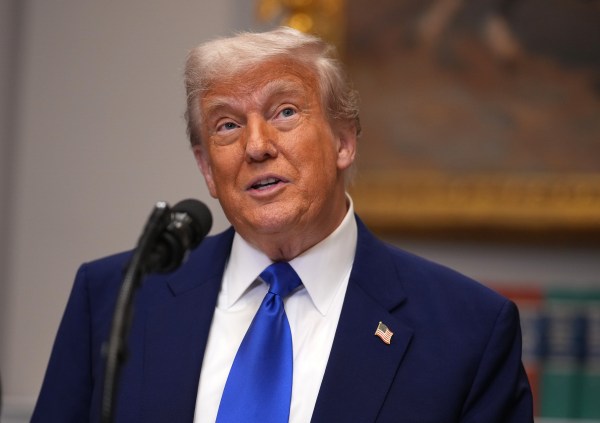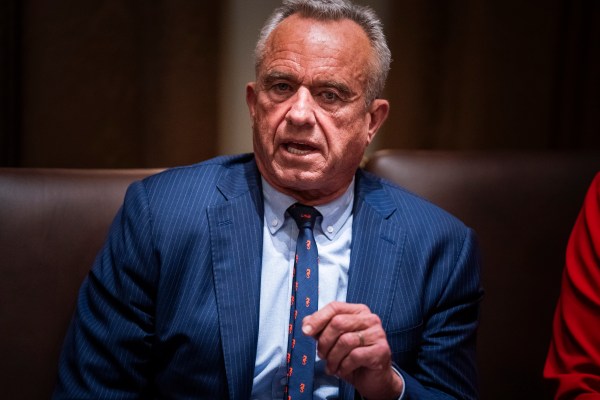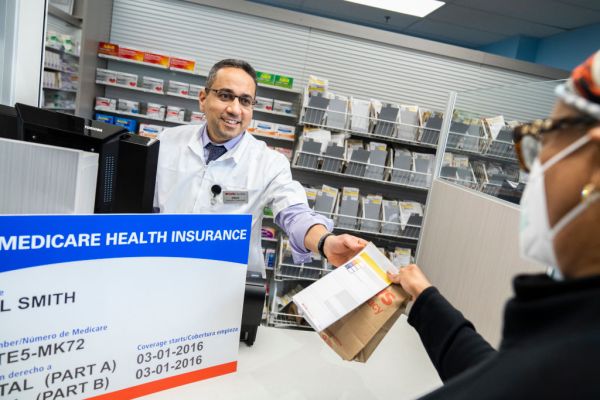More than 100 days into President Donald Trump’s second term, the administration has fallen into a pattern. Trump releases an executive order with an expansive title accompanied by even more expansive claims from the president and senior officials about the effects of the directive. The announcement gets the headlines Trump is looking for. But despite the billing, the order is light on specifics and reliant on uncertain legal footing.
Such was the case earlier this week when Trump signed an executive order targeting drug costs. The order scrutinizes both pharmaceutical manufacturers and foreign countries where brand-name drugs are often available to patients at significantly cheaper prices than in the United States. The president asserted drug prices will drop by as much as “80, and 90 percent” as a result of the order.
But the executive order reflects at best the “concepts of a plan,” rather than a serious attempt at drug policy reform. It’s unclear whether the order targets drug prices in public insurance programs like Medicare and Medicaid or extends to the private market, and the specific path to actually achieving such steep reductions is even less clear.
The president is correct that there are large discrepancies between what people in the U.S. and other nations pay for the same drugs. Wealthy countries like the United Kingdom with nationalized health care or single-payer systems set drug price controls. Since the government is setting limits, prices can be kept down, but such a system involves trade-offs, namely, slower and more limited access to the full range of pharmaceuticals, including some lifesaving drugs for diseases like cancer.
In the U.S., there is no central government body deciding what drugs, after the Food and Drug Administration determines they’re safe, can be sold and at what price. Prices are instead negotiated among drug manufacturers, health insurers, pharmacy benefit managers—companies that health plans either own or contract with to manage their prescription benefits—and pharmacies. Private insurers lack the legal power of the state and account for only individual portions of total drug spending—a particular health plan represents only a piece of the population, compared to a public insurance system where everyone is covered by the government—consequently, they have less negotiating leverage to keep prices down.
To the president, the result of the differing systems is that the rest of the developed world is freeloading on pharmaceutical innovations that are paid for by higher prices in the U.S. “The inflated prices in the United States fuel global innovation while foreign health systems get a free ride,” the order noted.
During Trump’s first administration, Trump attempted a more limited version of what he called “most-favored-nation” pricing, also known as international reference pricing, a policy that would tie domestic pharmaceutical prices to the cheaper rates paid by other developed countries. His 2020 attempt applied only to a pilot program for select high-cost drugs covered by Medicare, but it was blocked in court and subsequently abandoned by the Biden administration.
Monday’s executive order titled “Delivering Most-Favored-Nation Prescription Drug Pricing to American Patients” doesn’t involve another pilot program or a substantive roadmap for policy reform. Instead, the order reflects a vague attempt at price controls via pressuring pharmaceutical manufacturers into lowering U.S. prices and compelling foreign governments to make up the difference in lost U.S. revenue by paying drug companies more. The order directs the secretary of health and human services to set price targets, seemingly for both public programs and the private market. As the Cato Institute’s Michael Cannon has noted, the executive branch lacks the legal authority to impose price controls in the private market, so the order takes a carrot-and-stick approach to push drug companies to cooperate voluntarily.
The carrot involves directing the secretary of commerce and the U.S. trade representative to take action to get other developed countries to pay higher prices than they do currently. In return, drug companies will lower U.S. prices to “equalize,” in the president’s words, domestic and international rates.
It’s unclear how the administration could force other countries to pay higher prices. Trump said Monday he’d use tariffs to pressure foreign governments. Even if the president could successfully apply trade leverage, such changes would necessarily involve health policy and statutory overhauls within those countries.
The president also directed the Department of Health and Human Services (HHS) to, within 30 days, “communicate most-favored-nation price targets to pharmaceutical manufacturers to bring prices for American patients in line with comparably developed nations.” If the companies don’t agree to the targets, then they get the stick. HHS will “propose a rulemaking plan to impose most-favored-nation pricing” and take steps to facilitate greater importation of drugs to put downward pressure on domestic prices. The order also threatens antitrust action from the Justice Department and the Federal Trade Commission as well as potential revocation of drug approvals by the Food and Drug Administration.
“Big Pharma will either abide by this principle voluntarily or we will use the power of the federal government to ensure we are paying the same price as other countries,” Trump said.
Pharmaceutical manufacturers seem more than happy to watch the president lean on foreign governments to pay them more. “The Administration is right to use trade negotiations to force foreign governments to pay their fair share for medicines,” Stephen Ubl—CEO of the Pharmaceutical Research and Manufacturers of America (PhRMA), the industry’s powerful trade and lobbying group—said in a statement on Monday. “U.S. patients should not foot the bill for global innovation.”
But the industry will no doubt oppose attempts to cap U.S. prices. “Importing foreign prices from socialist countries would be a bad deal for American patients and workers,” Ubl added, saying price controls would decrease pharmaceutical innovation and domestic economic investment.
It’s unclear whether or to what degree the executive branch can legally impose most-favored-nation pricing, and much will depend on the scope and specifics of any future rulemaking. “[The order] seems to me like it could be Medicaid or Medicare or the private market or some combination of the above,” Tevi Troy, a senior fellow at the Ronald Reagan Institute and deputy HHS secretary during the George W. Bush administration, told The Dispatch. “I’m not sure what it applies to, and if it does apply, it’s not clear to me that this is within the realm of the executive branch to declare it by fiat, so it might have to be done by Congress.” For example, the Biden administration instituted its Medicare drug price negotiation program as part of the Inflation Reduction Act.
HHS Secretary Robert F. Kennedy Jr. was asked in an interview Monday on Fox Business whether the price cuts would apply to Medicare Part D. “They absolutely will,” he said. “And they’ll apply in the private market as well.”
If the order does in fact apply to both public and private pharmaceutical prices, the process of setting price targets and or completing a rulemaking process would be lengthy and complex. “It’s like a lot of [executive orders],” Ben Ippolito, a senior fellow at the American Enterprise Institute studying health care economics, told The Dispatch. “It’s signaling direction, it’s signaling intent, it’s signaling interest, but there’s not a lot of immediate action.”
The lack of specifics and the teeth of accompanying legislation are likely why industry observers reacted positively to the order. As news of Trump’s plans seeped out over the last week, drug companies feared the president might insist congressional Republicans include a drug price cap policy in their reconciliation package. When such a provision failed to materialize, the stocks of pharmaceutical companies experienced a slight bump on Monday after Trump signed the order.
Politically, the president may have gotten all that he’s looking for from simply the appearance of taking on Big Pharma. Drug companies are among the least popular companies in the country, and high drug prices are a potent issue, drawing the ire of voters of all stripes. Trump’s framing of the problem is straightforward to understand. In his telling, high prices aren’t the result of an array of complex forces and practices throughout the pharmaceutical supply and financing systems—including Medicare payment policies, commercial health insurers, manufacturers, wholesalers and distributors, and pharmacy benefit managers. Rather, it’s as simple as other countries paying too little, and if they pay more, then we’ll pay less.
From a policy perspective, drug pricing is a much more complicated question involving deeply challenging trade-offs between access to current drugs and investment in new, life-saving therapies. Some health policy analysts argue high costs could be better addressed by tackling that question directly rather than attempting to leverage price reductions on the back of other governments’ pricing regimes.
“In some ways, it’s neither here nor there that some other country does something different than us,” Ippolito said. “We have a Congress. We have public programs. We can decide how we’d like to pay for pharmaceuticals in those settings. If you want to change it, just change it and make that decision based on what you think is the best balance of trade-offs, because what you do matters so much more than what any of these other countries are doing.”










Please note that we at The Dispatch hold ourselves, our work, and our commenters to a higher standard than other places on the internet. We welcome comments that foster genuine debate or discussion—including comments critical of us or our work—but responses that include ad hominem attacks on fellow Dispatch members or are intended to stoke fear and anger may be moderated.
With your membership, you only have the ability to comment on The Morning Dispatch articles. Consider upgrading to join the conversation everywhere.